Whether you’re a turf manager maintaining rugby fields or just a rugby fan, it’s important to know more about the playing field. After all, without the field, there would be no game. In this article, we will discuss everything you need to know about rugby fields. We’ll cover dimensions, markings, and other important information. So whether you’re an avid rugby fan or just looking to understand the game a little better, read on!
- Rugby Field Dimensions
- Rugby Field Components Explained
- Rugby Field Markings Explained
- How to mark the lines on a rugby field
How to paint professional rugby fields with a line marking robot ->
What is rugby?
Rugby is a sport that many people enjoy, invented in England in 1823. It is a physically demanding sport that requires a lot of stamina, strength, and agility. The game is played with two teams of fifteen players on each team. The object of the game is to score more points than the other team by getting the ball into the other team’s end zone. Rugby is played with an oval-shaped ball on a large field with H-shaped goalposts at each end.
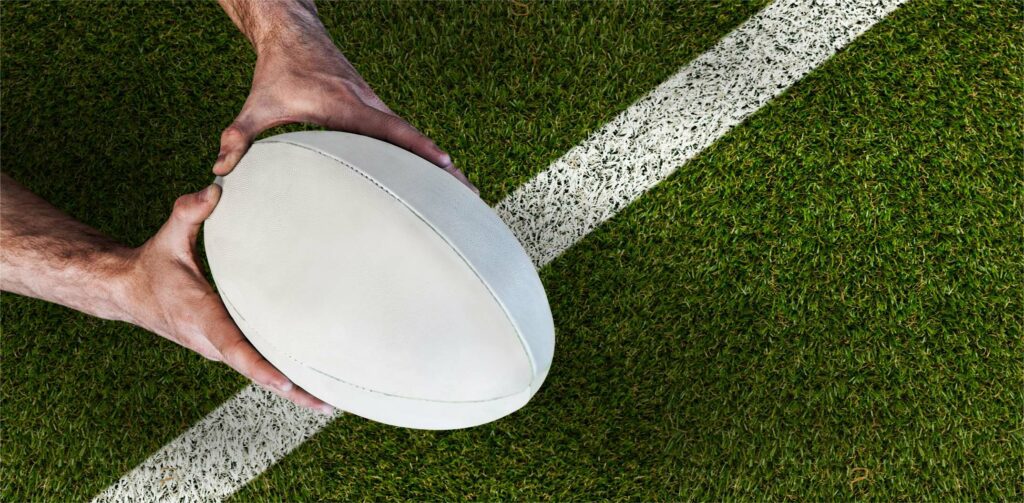
Rugby field dimensions
A rugby field, also known as a pitch, is the playing surface for the sports of rugby, that is rectangular in shape and made of grass.
A rugby field measured from goal line to goal line must be a minimum of 103 yards (94m) and up to 109 yards (100m) in length, and between 74-76.5 yards (68-70m) in width.
The in-goal area at each end, ranging from 11-24 yards (6-22m), extends the total length of the field to 114-133 yards (68-70m).
The entire playing area measures between 7,208 and 10,080 m2.
| Length goal line to goal line | 94m - 100m (103-109 yds) |
|---|---|
| In-goal area | 6m - 22m (11-24 yds) |
| Total length (incl. in-goal area) | 100m - 122m (114-133 yds) |
| Width | 68m - 70m (74-76.5 yds) |
| Playing area | 7,208 and 10,080 m2 (8,706 - 12,055 yds2) |
Rugby field components explained
To better understand a rugby field dimensions, we should take a look at the different components of the field, to visualize it.
The playing enclosure
The playing enclosure, which is defined by a fence, advertising boards, or seats, represents the entire playing area and the space around it.
The field of play
The field of play is the space created by the goal lines and the touch lines. This is where the bulk of the game’s action happens.
The playing area
The playing area is composed of the field of play and in-goal areas. If the ball goes outside the playing area, the game is halted and a restart is required.
In-goal
The in-goal area is the space between the goal line and dead ball line, and between the touch-in-goal lines. This is one of the most important parts of the rugby field, as it represents where the team tries to score touches.
The 22 area
The 22 area is the space between the goal line and the 22-meter line. This area is used for scrums, line-outs, and other set pieces.
Rugby Field Markings Explained
The lines on a rugby field serve an important purpose in the game. They demarcate the playing area and help players know where they are on the field. There are a lot of lines on the rugby field. So let’s take a look at each one, learn its name, its dimensions and the role it plays in the game.
Solid Lines
The solid lines on a rugby field are:
The Touchlines
The Goal Lines
The 22-meter Lines
The Halfway Line
The Deadball Line
The Touchlines
The touchlines, also called sidelines, run along the length of the rugby field and mark the outer boundary of play. If the ball or a player carrying it touches or crosses a touchline, play stops and a line-out is awarded to the team that did not last touch the ball. The distance between the goal lines, which the touchlines border, must be between 103 and 109 yards (94-100 meters). At each end, the touchlines continue past the goal lines as the touch-in-goal lines, which form the side boundaries of the in-goal areas.
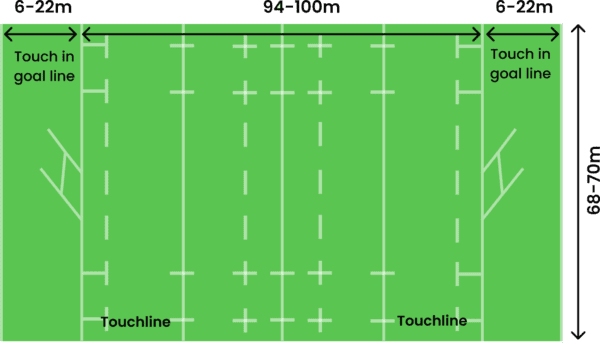
The Goal Lines
The goal lines, also known as try lines, are the shorter sides of the rugby field, at each end of the field, which lay perpendicular to the touchlines. In the middle of the goal lines are the goal posts. This is the place that creates the most excitement for the fans, because it represents where teams can score tries. A try is worth five points and is scored when a player touches the ball down in their opponent’s in-goal area.
The goal line must be between 68-70m (74-76.53yds).
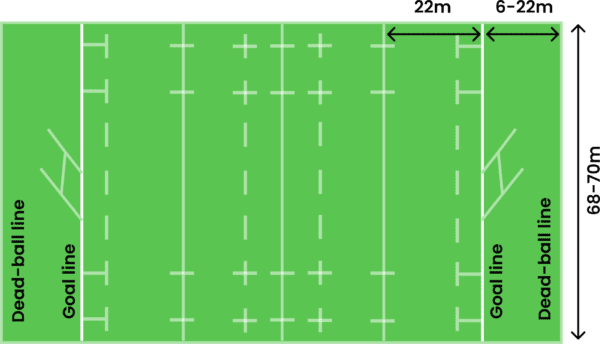
The 22-meter Lines
The 22-meter lines run parallel to the goal lines, each positioned 22 meters from its respective try line. Together with the goal line and touchlines, they define what’s known as “the 22” — a key tactical area in rugby. Special kicking rules apply here, and the line also serves as a reference point for certain restarts, such as drop-outs, and for positioning during penalty kicks. Each 22-meter line matches the length of the goal line it parallels, measuring between 74 and 76.5 yards (68-70 meters).
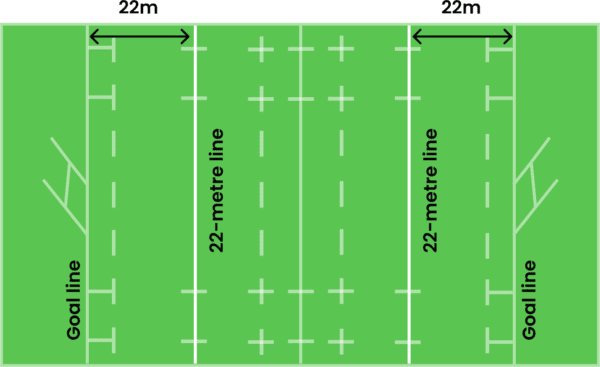
The Halfway Line
The halfway line, as its name suggests, is a line running through the center of the field, which divides the field in half. It is perpendicular to the touchlines and parallel to the goal lines. The halfway line is the place where the game begins and also where the game is restarted after a team scores a try or conversion. It is also used to determine which team has possession of the ball in a scrum, line-out or penalty kick.
The halfway line must be between 68-70m (74-76.53yds) and it is placed at the halfway distance from goal lines at 47-50m.
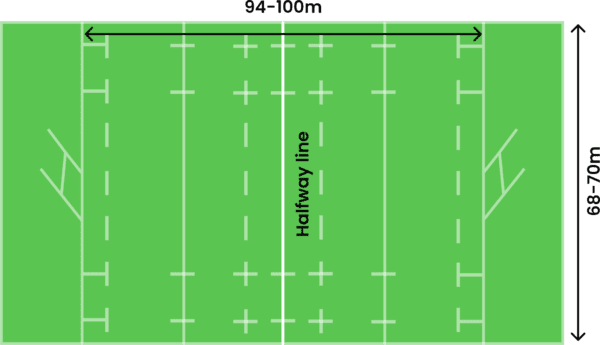
The Deadball Line
The dead-ball line is placed at the back of each in-goal area and is parallel to the goal line. It represents the boundary of the playing area. If the ball goes out of bounds behind the dead-ball line, play is stopped and a scrum is awarded to the team that did not touch the ball last.
The dead-ball lines should be between 68 and 70 meters long, with a minimum distance of 6 meters from the goal line and a maximum distance of 22 meters.
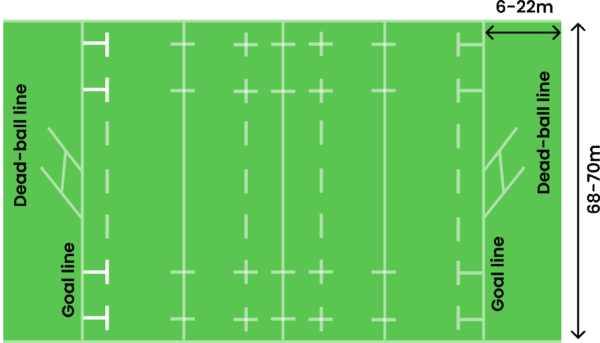
Dashed lines
Apart from the solid lines, there are also dashed lines on a rugby field. Each dash measures 5m.
Types of dashed lines:
The 10-meter Dash Lines
The 5-meter Dash Lines
The 15-meter Dash Lines
5-meter Lines from Goal Lines
The 10-meter Dash Lines
The 10-meter dash lines are two sets of dash lines that are placed 10 meters from the halfway line, on its both sides.
When a kickoff is made using a drop kick, the ball must travel at least 10 meters beyond the halfway line, so the 10-meter lines play an important role when a game starts or restarts.
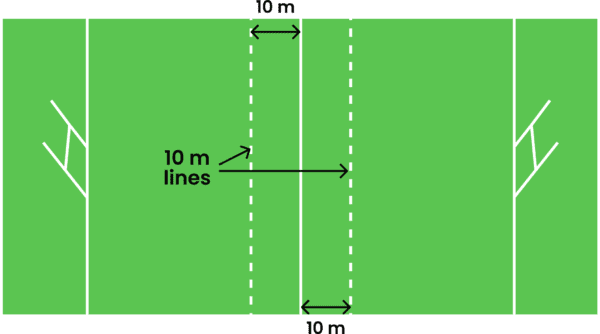
The 5-meter Dash Lines
The two sets of dash lines which are 5 meters from, and parallel to, each touchline, are called the 5-meter dash lines. This is the minimum distance from the touchlines and goal lines at which a scrum can take place.
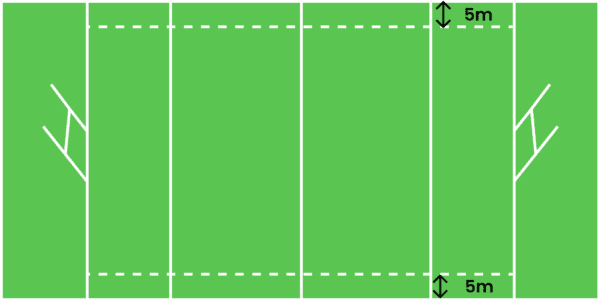
The 15-meter Dash Lines.
The 15-meter dash lines are two sets of dash lines that are 15 meters from, and parallel to, each touch line. The 15-meter line is used for throw-ins – if the ball crosses this line, it can be played by anyone.
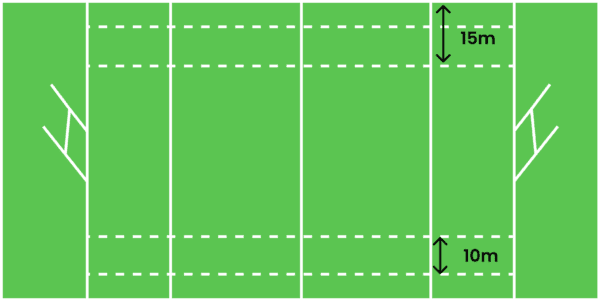
5-meter Lines from Goal Lines
These 5-meter lines are parallel to the goal lines and they intersect the 5 and 15-metre lines
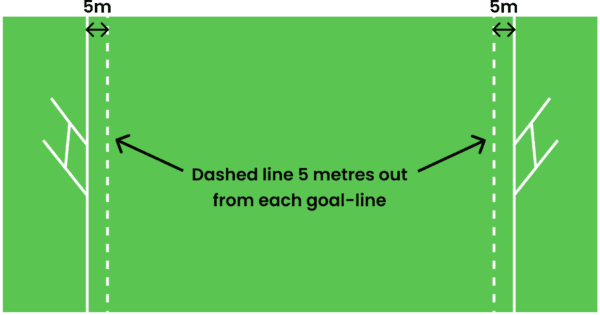
What is the width of the lines in rugby?
The width of the lines in rugby can vary from 0.16f (5cm) to 0.49f (15cm).
How to mark rugby fields
Now that you know all about the different lines on a rugby field, it’s time to get into painting those lines!
To mark a rugby field, you will need:
- A measuring tape
- A long rope or cord
- flags or cones (optional)
- Paint
- A line marking machine
Make sure to bring all the necessary materials and bring along two more colleagues. Fill your machine with paint and follow these steps:
Turf Tank pro tip:
Marking a rugby field manually is a complex task, requiring a lot of time and attention to detail. Why complicate when you can have a robot paint the field for you? The Turf Tank autonomous line marking robot paints a rugby field all by itself.
1 – Measure the length and width of the field.
Firstly, take the measuring tape and measure out the length and width of the field.
Ensure you will keep your field between the minimum length of 94 meters (103 yards), and the maximum length of 100 meters (109 yards). Also ensure the width is according to the rules, between 68 meters (74 yards), and 70 meters (76.5 yards).
2 – Mark the outline of the field.
2a. Start with the touchline on one side
Have two in the team hold the string straight where the touchlines will be painted. Then the third person needs to keep a straight line as you push the line marker along the strings.
2b. Do exactly the same on the touchline on the other side.
Make sure that the lines are straight and that they’re the same width all the way along.
2c. Mark the goal lines
- Mark the inside lines
Then, mark out the 22-meter lines, the halfway line, and the dead-ball lines. Again, make sure that these lines are straight and of consistent width.
- Finally, mark out the sets of dashed lines.
Remember that each dash should be five meters long.
How to mark Rugby Fields – the easy way
Marking a rugby field manually can be a complicated job. It requires 3 people and lot of hours, and the end result might have crooked lines. Why complicate when you can have a robot paint the field for you?
With the Turf Tank line marking robot all you need is 5 minutes to paint a rugby field. No more effort!
- Fill the robot with paint
- Select the rugby field layout on your tablet
- Press start.
That’s it!
The robot will now go to the starting point and begin painting all by itself, finishing the entire rugby field in just 35 minutes. With the time you save while the robot marks autonomously, you are free to focus on other tasks around the facility.
Curious to see how easy you can paint rugby fields? See the robot live on your fields!


